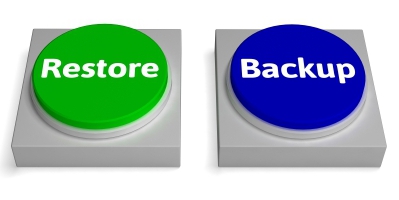
Itís all about the Restore
Hybrid Cloud Backup
A hybrid cloud backup is a combined on-site backup with a cloud backup.
Why do you want this ďcombinationĒ backup?
Neither the on-site backup nor the cloud backup will individually meet all of a businessís data restore requirements.
Cloud Backup
At a quick glance, an all cloud backup solution seems to be a great option as it has the features everyone wants; a copy of your data in a safe off-site location, no manual changing of tapes or disks, and everything is automatic. Sounds good! Except when it comes to restoring data; the issue lies in the speed of your internet, rather than the backup itself.
We think we have high speed Internet but in fact it is fairly slow speed compared to what modern networks are capable of. So what happens when you need to restore more than a few files from your cloud backup, say a disk crashes and you need 150 G or 300 G or more of data restored? A simple calculation will tell you that with average business Internet connection speeds, the restoration of 300 G of data can take from 30 hours to 60 hours; that is if there are no interruptions or errors. Two or more days is a long time to wait to get to your data. Downtime costs money, the longer you have to wait for your data, the longer you canít work and the more expensive it gets.
On-Site Backup
The on-site backup has the definite advantage when it comes to the speed of restoring data. An on-site backup is connected directly to your network and you can restore 300 G in an hour or two depending on the technology. The benefit of an on-site backup however is also its downfall; your backup data is on-site where it can be destroyed along with the original data, such as in a fire, flood or other disaster.
For real protection, with every on-site backup we need to have a way to get a current copy of the data off-site. We can manually take disks or tapes off-site; however, there are risks to that. For example the person in charge of taking the tapes off-site may forget, tapes may get damaged, stolen, or lost. So we need a better solution.
Hybrid Backup
The hybrid backup gives you the best of both technologies, an on-site component for the fast restores needed in most situations and a cloud (off-site) component for the disaster situation. The hybrid backup like the cloud backup is fully automated and does not require the changing of tapes or disks. The on-site backup is a drive on the server that backs up the data, just as if it was an on-site only backup, but the drive stays on-site at all times.
Blue Triangle IT Solutions' hybrid backup has the added advantage that your data is here in Toronto Ontario Canada and does not cross borders. If you ever did have a disaster and require a large restore from the cloud, we can deliver it directly in far less time than an Internet download.
Disaster Recovery (DR)
Every business needs a disaster recovery plan. That is, if you want to stay in business! How do you know what type of disaster recovery plan you need for your IT systems?
Small Business
If you are a small business then your backup system may fulfill your needs for disaster recovery without any additions. As an example our Hybrid Cloud Backup solution provides a simple disaster recovery built in. Contact us to see if Hybrid Cloud Backup is all you need for your DR.
Large business or Regulated Industry
If you are a larger business or if you are in a regulated industry such as financial services then you have additional requirements for a disaster recovery solution. You not only need to have your data available at a DR site, but you also need to consider your recovery time object for each application (how long you can be without access to the data or application). What is your tolerance for data loss per application? Does the DR site meet your compliance requirements?
Another very important item to consider is that you may need to actually use the DR system from time to time for running DR tests or meeting industry guidelines. We know that every disaster recovery system should be tested to make sure the data is there and it can be relied upon, but there is a big difference between simply turning on a DR server to see if it works and actually running a full test where you use the system for hours or days.

When using a normal backup system for your disaster recovery system, you may be able to spin up a virtual copy of your servers on the backup system, but this may be a one way street. With many backup based solutions there is no issue failing over from the main production server to the DR (backup) server but once you change the data on that DR server there is no way to get the data back to the production server. A DR system that requires you to restore the entire production server from the backup after each DR test is not a good solution. However, a good DR solution not only provides replication of data and services to the DR site but also provides a simple method to reverse the replication and bring any changed data back to the production site.
